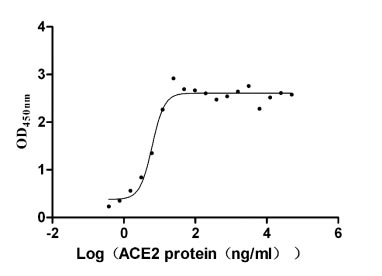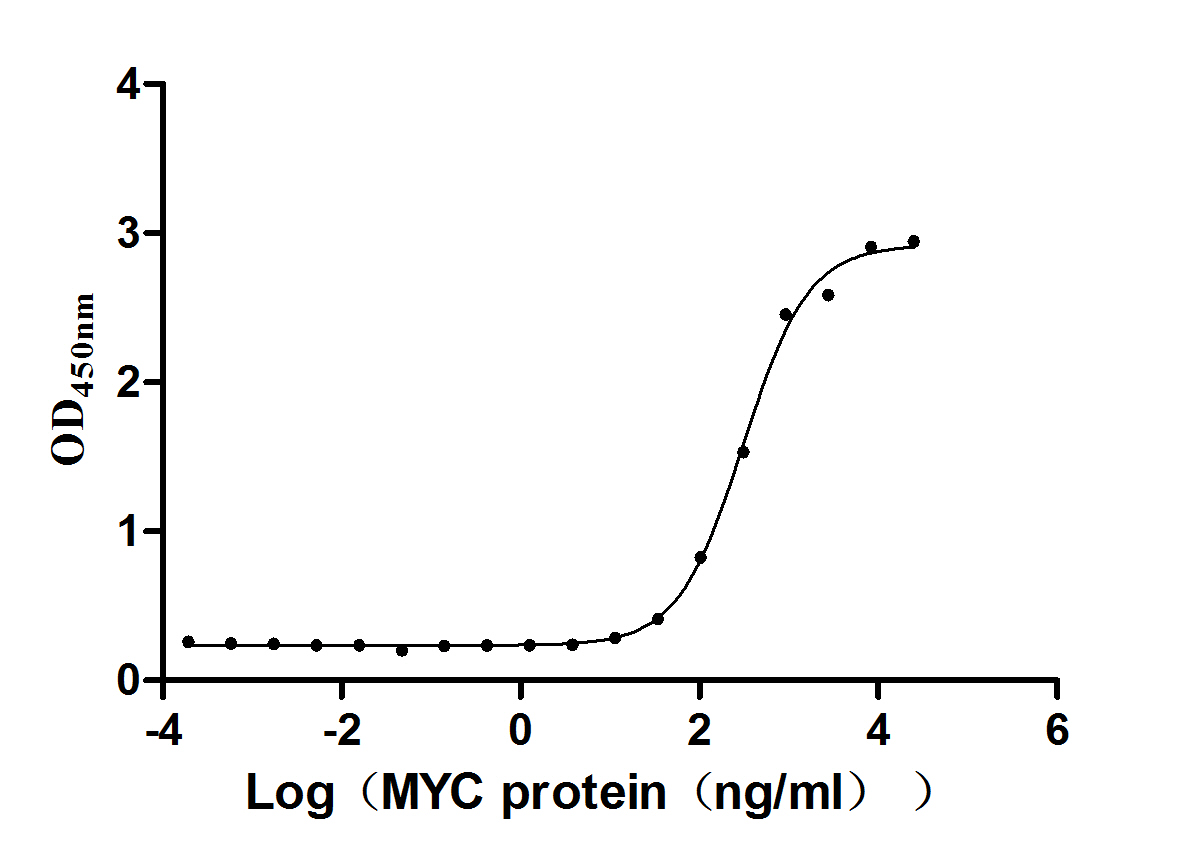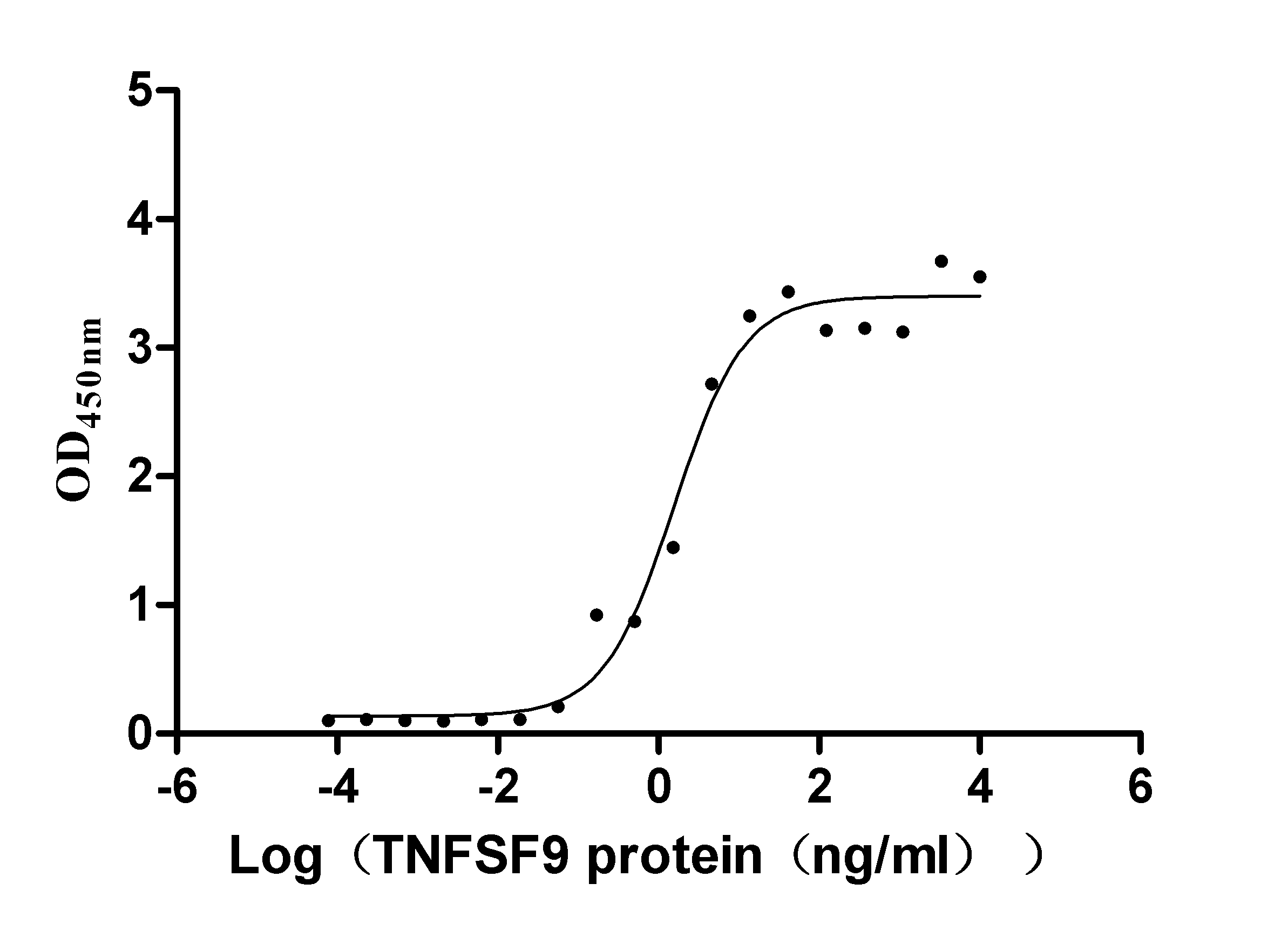Recombinant Human papillomavirus type 16 Protein E7 (E7)
-
货号:CSB-BP365855HML
-
规格:
-
来源:Baculovirus
-
其他:
-
货号:CSB-EP365855HML-B
-
规格:
-
来源:E.coli
-
共轭:Avi-tag Biotinylated
E. coli biotin ligase (BirA) is highly specific in covalently attaching biotin to the 15 amino acid AviTag peptide. This recombinant protein was biotinylated in vivo by AviTag-BirA technology, which method is BriA catalyzes amide linkage between the biotin and the specific lysine of the AviTag.
-
其他:
-
货号:CSB-MP365855HML
-
规格:
-
来源:Mammalian cell
-
其他:
产品详情
-
纯度:>85% (SDS-PAGE)
-
基因名:Name:E7
-
Uniprot No.:
-
别名:E7; Protein E7
-
种属:Human papillomavirus type 16
-
蛋白长度:full length protein
-
表达区域:1-98
-
氨基酸序列MHGDTPTLHE YMLDLQPETT DLYCYEQLND SSEEEDEIDG PAGQAEPDRA HYNIVTFCCK CDSTLRLCVQ STHVDIRTLE DLLMGTLGIV CPICSQKP
-
蛋白标签:Tag type will be determined during the manufacturing process.
The tag type will be determined during production process. If you have specified tag type, please tell us and we will develop the specified tag preferentially. -
产品提供形式:Lyophilized powder
Note: We will preferentially ship the format that we have in stock, however, if you have any special requirement for the format, please remark your requirement when placing the order, we will prepare according to your demand. -
复溶:We recommend that this vial be briefly centrifuged prior to opening to bring the contents to the bottom. Please reconstitute protein in deionized sterile water to a concentration of 0.1-1.0 mg/mL.We recommend to add 5-50% of glycerol (final concentration) and aliquot for long-term storage at -20℃/-80℃. Our default final concentration of glycerol is 50%. Customers could use it as reference.
-
储存条件:Store at -20°C/-80°C upon receipt, aliquoting is necessary for mutiple use. Avoid repeated freeze-thaw cycles.
-
保质期:The shelf life is related to many factors, storage state, buffer ingredients, storage temperature and the stability of the protein itself.
Generally, the shelf life of liquid form is 6 months at -20°C/-80°C. The shelf life of lyophilized form is 12 months at -20°C/-80°C. -
货期:Delivery time may differ from different purchasing way or location, please kindly consult your local distributors for specific delivery time.Note: All of our proteins are default shipped with normal blue ice packs, if you request to ship with dry ice, please communicate with us in advance and extra fees will be charged.
-
注意事项:Repeated freezing and thawing is not recommended. Store working aliquots at 4°C for up to one week.
-
Datasheet :Please contact us to get it.
相关产品
靶点详情
-
功能:Plays a role in viral genome replication by driving entry of quiescent cells into the cell cycle. Stimulation of progression from G1 to S phase allows the virus to efficiently use the cellular DNA replicating machinery to achieve viral genome replication. E7 protein has both transforming and trans-activating activities. Induces the disassembly of the E2F1 transcription factor from RB1, with subsequent transcriptional activation of E2F1-regulated S-phase genes. Interferes with host histone deacetylation mediated by HDAC1 and HDAC2, leading to transcription activation. Plays also a role in the inhibition of both antiviral and antiproliferative functions of host interferon alpha. Interaction with host TMEM173/STING impairs the ability of TMEM173/STING to sense cytosolic DNA and promote the production of type I interferon (IFN-alpha and IFN-beta).
-
基因功能参考文献:
- A role for E7 protein in regulation of Langerhans cells homeostasis in the skin and in suppression of antigen specific CD8 T cell expansion. PMID: 27708419
- E7 oncogene alters host gene expression in the cervical stroma. PMID: 29073104
- direct evidence that both A3A and HPV16 E7 interact with CUL2, suggesting that the E7-CUL2 complex formed during HPV infection may regulate A3A protein levels in the cell. PMID: 29367246
- Results suggest that E7 recruited CUL2, driven by CUL2/E2F1/miR-424 regulatory loop, is overexpressed and accelerates HPV16-induced cervical carcinogenesis. PMID: 27153550
- The human papillomavirus E7 oncoprotein is a regulator of host transcription. (Review) PMID: 27818212
- Findings indicate the interaction network of viral oncogene HPV16 E7, miR-27b and PLK2, and support the potential strategies using antisense nucleic acid of miR-27b for therapy of cervical cancer. PMID: 26910911
- Based on experimental data obtained from E7 proteins from the prototypical viral types 16, 18 and 11, we identified a couple of low pKa nucleophilic cysteines that can form a disulfide bridge upon the exposure to ROS and regulate the cytoplasm to nucleus transport PMID: 27863297
- E7 is major transforming oncoprotein of human papillomavirus 16 and serves as paradigmatic example of intrinsically disordered proteins due to its N-terminal disordered domain. Data suggest mutation of leucines in N-terminal intrinsically disordered domain of E7 leads to pronounced increase in both alpha-helix and beta-sheet structures; thus, E7 appears to exhibit local structural elements that oppose canonical folding. PMID: 28952717
- s observed thousands of unique HPV16 genomes; very few women shared the identical HPV16 sequence, however, E7 was devoid of variants in precancers/cancers compared to higher levels in the controls; this was confirmed in cancers from around the world. Strict conservation of the 98 amino acids of E7, which disrupts Rb function, is critical for HPV16 carcinogenesis. PMID: 28886384
- study determined that high-risk E7 proteins target the proteolysis of the cellular protein tyrosine phosphatase PTPN14 and find that this activity is correlated with the retinoblastoma-independent transforming activity of E7 PMID: 27651363
- Increased phosphorylation of the N29S of E7 increases interaction with TBP and pRb and viral transforming activity. PMID: 27829177
- HPV16 E7 oncoprotein upregulates Oct3/4, Sox2, Nanog and Fgf4 expression to maintain the self-renewal capacity of cancer stem cells. PMID: 27693927
- result indicates that cervical cancers do not require the continuous expression of E7 on the Fanconi anemia pathway-deficient background PMID: 27190216
- the level of Cdc6 phosphorylation at serine 54 (S54P) was increased in E7-expressing cells. S54P was associated with an increase in the total amount of Cdc6 and chromatin-bound Cdc6. DNA damage-enhanced upregulation and chromatin binding of Cdc6 appeared to be due to downregulation of cyclin-dependent kinase 1 (Cdk1) as Cdk1 knockdown increased Cdc6 levels PMID: 27207654
- PTPN14 is classified as a potential tumor suppressor protein, and is very susceptible to HPV E7-induced proteasome-mediated degradation. PMID: 28100625
- study found that HPV-16 decreased the phosphorylation of AKT (pAKT) and that this is a function of E7 that is independent of the Rb degradation function PMID: 27030265
- These data suggest that the HPV16 E7 oncoprotein impairs the function and morphology of dendritic cells and induces the systemic accumulation of CD11b(+)Gr1(+) cells. PMID: 27478837
- the structural features of the flexible N-terminal region (46 residues) of E7, were investigated. PMID: 27418281
- The human papillomavirus type 16 oncogene E7 may affect STK31 expression through a DNA methylation-mediated mechanism. PMID: 27044426
- HPV16 E7 protein can up-regulate host miR-21 expression, thus elevating cervical carcinoma cell growth, proliferation and invasion. PMID: 26884851
- These data suggest that local expression of HPV16-E7 in keratinocytes can contribute to persisting infection with this oncogenic virus, by altering the phenotype and function of local APCs. PMID: 27031095
- Results found that HPV16 E7 increases RARB mRNA and protein expression both in vitro and in the cervix of young K14E7 transgenic mice suggesting that RARB overexpression is part of the early molecular events induced by the E7 oncoprotein. PMID: 26173416
- E7 localised to the plasma membrane in cervical cancer cells. PMID: 26131956
- findings suggest that increased IL-17A expression by macrophages in E7-expressing skin exposed to DNCB promotes arginase-1 induction and contributes directly to the observed hyperinflammation. PMID: 25720383
- the modulation of HPV-16 E6/E7 expression remarkably influenced cell proliferation, migration, and invasion, as well as the protein levels of E-cadherin and P-cadherin in cervical cell lines. PMID: 26093522
- The data showed that E7 induced CCNA1 methylation by forming a complex with Dnmt1 at the CCNA1 promoter, resulting in the subsequent reduction of expression in cancers. PMID: 26250467
- In 10 microg/ml BV-treated CaSki cells, the mRNA expression and protein levels of HPV16 E7 were significantly decreased. The mRNA and protein expression levels of HPV16 E7 were decreased by bee venom in TC-1 tumors. PMID: 25633640
- that mast cells, recruited towards CCL2 and CCL5 expressed by epithelium induced to proliferate by Human Papillomavirus 16 E7 protein PMID: 25340820
- These results point to a mutually functional interaction between p14ARF and E7 that might partly explain why the sustained p14ARF expression observed in most cervical pre-malignant lesions and malignancies may be ineffective. PMID: 24798431
- In genetically engineered mouse models expressing HPV16 oncogenes in stratified squamous epithelia, HPV16 E7, alone or together with E6, led to an accumulation of epithelial cells harboring gamma-H2AX nuclear foci. PMID: 25216575
- Data indicate that HPV16E7, CBP/p300, and retinoblastoma protein pRb interactions are potentially important for cellular transformation. PMID: 25451029
- Our results demonstrate that HPV16.E7 protein enhances drug associated production of arginase-1 by myeloid cells and consequent inflammatory cellular infiltration of skin. PMID: 24732401
- The aim of the present study was to investigate the cytotoxicity of natural killer (NK) cells to CaSki cells following knockdown of the E7 protein of the human papillomavirus type 16. PMID: 24566606
- Results show that E7 interacts with the B-Myb, FoxM1 and LIN9 components of this activator complex, leading to cooperative transcriptional activation of mitotic genes in primary cells and E7 recruitment to the corresponding promoters. PMID: 24141769
- E7 induces cancer by causing DNA damage at least in part through the inactivation of pocket proteins. PMID: 24013229
- E7 induces human papillomavirus-associated head and neck cancers by promoting DNA damage through the inactivation of pocket proteins. PMID: 24086435
- HPV16 E7 oncoprotein increases production of the IL18BP in keratinocytes. PMID: 24478434
- The seven cysteines in HPV16 E7 remain reduced in conditions resembling the basal reduced state of a cell. PMID: 24559112
- This study demonstrates that the cdk inhibitor p16INK4A is required for high-level expression of the E7 oncoproteins of HPV-16, HPV-18, and HPV-45 in cervical carcinoma cells. PMID: 24599991
- These data suggest that the interaction of human papillomavirus E7 with p190 dysregulates this GTPase activating protein and alters the actin cytoskeleton. PMID: 24403595
- Matrix metalloproteinases (MMP)--MMP-1,-2,-9 and its endogenous activity regulators in transformed by E7 oncogene HPV16 and HPV18 cervical carcinoma cell lines PMID: 24479343
- E7 proteins of different types of human papillomaviruses disrupted pocket protein-DREAM complexes in a similar extent. PMID: 24294959
- hTERT cooperates with HPV16 E7 protein in mediating bypass of the senescence blockade and effecting cell immortalization PMID: 23592995
- Human papillomavirus type 16 E7 expression causes increased EMI1 mRNA expression and also inhibits EMI1 degradation. PMID: 24074588
- that a patch of hydrophobic residues, 65LRLCV69, within the zinc-binding domain of HPV16 E7 mediates its nuclear import via hydrophobic interactions with the FG domain of the central channel nucleoporin Nup62. PMID: 24074597
- HPV16-induced TLR9 down-regulation affects the interferon response which negatively regulates viral infection PMID: 23752229
- s investigated the effect of E7 on the late promoter and found that E7 was able to activate the promoter. PMID: 23725693
- expression of a single oncoprotein in the epidermis is sufficient for lymphocyte trafficking (including immunosuppressive lymphocytes) to premalignant skin PMID: 23469070
- Human papillomavirus 16 E7 Adenine647Guanine can be used as a candidate marker for the progression of the cervical neoplasia. PMID: 21535311
- These results demonstrate an important role for Cdt1 in human papillomavirus E7-induced rereplication and shed light on mechanisms by which human papillomavirus induces genomic instability. PMID: 23152514
显示更多
收起更多
-
亚细胞定位:Host cytoplasm. Host nucleus.
-
蛋白家族:Papillomaviridae E7 protein family
-
数据库链接:
KEGG: vg:1489079
Most popular with customers
-
Recombinant Paguma larvata Angiotensin-converting enzyme 2 (ACE2), partial (Active)
Express system: Mammalian cell
Species: Paguma larvata (Masked palm civet)
-
Recombinant Human papillomavirus type 16 Protein E7 (E7) (Active)
Express system: E.coli
Species: Human papillomavirus type 16
-
Recombinant Human Tumor necrosis factor ligand superfamily member 9 (TNFSF9), partial (Active)
Express system: Mammalian cell
Species: Homo sapiens (Human)
-
Recombinant Human Tumor necrosis factor receptor superfamily member 9 (TNFRSF9), partial (Active)
Express system: Mammalian cell
Species: Homo sapiens (Human)
-
Recombinant Human Tyrosine-protein kinase Mer (MERTK), partial (Active)
Express system: Mammalian cell
Species: Homo sapiens (Human)
-
Recombinant Human Prolactin receptor (PRLR), partial (Active)
Express system: Mammalian cell
Species: Homo sapiens (Human)
-
Recombinant Human Cannabinoid receptor 1 (CNR1)-VLPs (Active)
Express system: Mammalian cell
Species: Homo sapiens (Human)
-
Recombinant Mouse Claudin-18 (Cldn18)-VLPs (Active)
Express system: Mammalian cell
Species: Mus musculus (Mouse)









-AC1.jpg)










